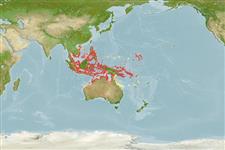>
Eupercaria/misc (Various families in series Eupercaria) >
Labridae (Wrasses)
Etymology: Diproctacanthus: Greek, di = two + Greek, proktos = anus + Greek, akantha = thorn (Ref. 45335).
More on author: Bleeker.
Environment: milieu / climate zone / depth range / distribution range
Ekologi
laut berasosiasi dengan karang; kisaran kedalaman 2 - 25 m (Ref. 90102), usually 2 - 20 m (Ref. 27115). Tropical; 24°C - 28°C (Ref. 27115); 19°N - 25°S, 99°E - 172°E
Western Central Pacific: Philippines, Palau, Indonesia, New Guinea, and Great Barrier Reef.
Size / Weight / umur
Maturity: Lm ? range ? - ? cm
Max length : 10.0 cm TL jantan/; (Ref. 6023)
deskripsi pendek
Kunci identifiaksi (pengenalan) | Morfologi | Morfometrik
Duri punggung (Keseluruhan (total)) : 9; duri punggung lunak (Keseluruhan (total)) : 9 - 10; Duri dubur: 2; Sirip dubur lunak: 9 - 11; vertebrata, bertulang belakang: 25. Juveniles with 3 broad black stripes from head to caudal fin where the stripes merge; with growth, lower stripe disappears, upper stripe is less distinct; black caudal fin becomes entirely yellow in adults. Head scales small. Lips thick and fleshy, forming a short tube when mouth is closed. Caudal fin rounded to truncate; pelvic fins rounded.
A solitary species (Ref. 90102) occurring in coral rich areas of shallow lagoons and sheltered seaward reefs. Adults feed mainly on coral polyps while juveniles remove ectoparasites from small territorial fishes (Ref. 2334, 9710). Adults swim in small groups. Usually, only small juveniles clean other fishes (Ref. 48636).
Life cycle and mating behavior
Maturities | Reproduksi, perkembang biakan | Spawnings | Egg(s) | Fecundities | Larva
Oviparous, distinct pairing during breeding (Ref. 205).
Randall, J.E., G.R. Allen and R.C. Steene, 1990. Fishes of the Great Barrier Reef and Coral Sea. University of Hawaii Press, Honolulu, Hawaii. 506 p. (Ref. 2334)
Status IUCN Red List (Ref. 130435)
ancaman kepada manusia
Harmless
penggunaan manusia
Perikanan: komersial; Akuarium: Komersial
Alat, peralatan
laporan khas
muat turun XML
Sumber internet
Estimates based on models
Preferred temperature (Ref.
123201): 26.8 - 29, mean 28.2 °C (based on 610 cells).
Phylogenetic diversity index (Ref.
82804): PD
50 = 1.0000 [Uniqueness, from 0.5 = low to 2.0 = high].
Bayesian length-weight: a=0.00912 (0.00466 - 0.01787), b=3.06 (2.89 - 3.23), in cm total length, based on LWR estimates for this species & (Sub)family-body (Ref.
93245).
Trophic level (Ref.
69278): 3.3 ±0.61 se; based on food items.
Daya lenting (Ref.
120179): Tinggi, Waktu penggandaan populasi minimum kurang dari 15 bulan (Preliminary K or Fecundity.).
Fishing Vulnerability (Ref.
59153): Low vulnerability (10 of 100).
Nutrients (Ref.
124155): Calcium = 121 [70, 214] mg/100g; Iron = 0.854 [0.488, 1.603] mg/100g; Protein = 18.3 [15.5, 20.6] %; Omega3 = 0.162 [0.099, 0.263] g/100g; Selenium = 22.3 [12.7, 40.8] μg/100g; VitaminA = 154 [47, 580] μg/100g; Zinc = 2.07 [1.39, 3.30] mg/100g (wet weight);
